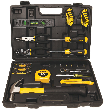Restoring Teak Parquet Flooring
Written by Lee Wyatt (last updated December 17, 2021)
Teak parquet flooring can be an elegant and exotic touch to any home. If you don't take care of it, or the previous owners of your new for you home didn't, there will come a time when it needs to be restored. Restoring teak parquet flooring can be a hugely overwhelming task, particularly if you have never worked with any kind of exotic wood before. Never fear, simply follow these simple step by step instructions and you will have beautifully restored your teak parquet flooring to its full glory.
- Vacuum. Start off your restoration process by vacuuming, yes vacuuming your teak flooring. Use a soft bristled extension vacuum and go over your entire floor. Using a vacuum will be a whole lot easier, and more efficient, then using a broom, since the suction from the vacuum will not only get rid of the majority of the dust, dirt, and grime that has built up over the years, but also will get everything out of the nooks and crannies that are inherent to wood.
- Sand. You will need to sand your floor in order to restore it. However, sanding a parquet floor is going to be different than sanding other kinds of wood flooring. When you sand you want to go with the grain of the wood, and not against it. Well, part of what makes parquet flooring so interesting is that the grains of the wood are not going in the same direction. This means that you will need to use a hand power sander, and not one of the big machines. Using a hand power sander, while more time consuming, will allow you greater control over your sanding. Start off with a heavy grit sand paper, use 36 grit, and work over your entire floor. Be sure that you change the sand paper frequently, and that you are using straight, even strokes that go with grain of sand. After working over the entire floor, repeat the process with 60 grit sandpaper, then again with 80, and finally one more time with 100 grit. Remember to use a decreasing amount of pressure each pass.
- Vacuum. After sanding your floor, you will need to clean up all the dust from the sanding. Start off by vacuuming everything once again. Go over your floor several times with a soft bristled vacuum extension to be sure that you get as much wood dust as you can. Be sure that you use a soft bristled extension to avoid scratching, gouging, or otherwise damaging the floor. After vacuuming, go over the floor with a soft bristled broom to get any wood dust that you may have missed. Finally go over the floor with a damp mop to get the rest of the dust.
- Stain. If you really want to bring out the color of your floor, use an appropriate stain. Simply apply the preferred stain according to the manufacturer's directions.Be sure that you have not missed any spots on your floor. Allow your flooring to dry completely between applications in order to achieve the proper color that you want.
- Finish. Once you have stained your floor (if you are staining it) it is time to finish the flooring. In this instance, what is meant by finishing, is to apply some sealer. While it is true that some finishes have sealer included, not all do. This means that you will want to be sure that you get a finish that has a sealer, or simply purchase some sealer. Sealing your floor will help protect it against wear and tear, as well as from any accidental spills or messes that may come along.
Author Bio
Lee Wyatt
Contributor of numerous Tips.Net articles, Lee Wyatt is quickly becoming a regular "Jack of all trades." He is currently an independent contractor specializing in writing and editing. Contact him today for all of your writing and editing needs! Click here to contact. Learn more about Lee...
Cleaning Garage Tools
Often the tools that we keep in our garage are in more need of a deep cleaning than the garage itself. In situations like ...
Discover More
Managing Lawn Pests
If you are really interested in having a beautiful and healthy lawn it only stands to reason you will want to reduce as ...
Discover More
Changing a Flat Tire
If there is one type of car repair that every car owner needs to know how to accomplish, then it has to be changing a ...
Discover More
More Home Improvement Tips
Hardwood Restoration without the Dust
Hardwood floors are gorgeous looking, and add character to any home. Unfortunately they are also a pain to refinish and ...
Discover More
Repairing Damaged Carpet
Just because you get a burn mark or worn area in your carpet doesn't mean you need to get new carpet. Here's some ideas ...
Discover More
Installing a Decorative Border
Are you having some hardwood floors installed? If so, then you may want to consider installing a decorative border. A ...
Discover More

Comments